How to Interpret Common Math Symbols and Their Meanings
In mathematics, symbols are used to represent operations, relationships, and concepts succinctly. For example, the plus symbol (+) denotes addition, while the minus symbol (−) signifies subtraction.
Multiplication is often represented by an asterisk (*) or a dot (·), and division by a slash (/) or a division sign (÷). Set theory symbols like \(\in\) indicate membership, and \(\subseteq\) signifies a subset.
Advanced mathematics employs symbols such as \(\Sigma\) for summation and \(\Pi\) for product operations. These symbols provide a foundation for understanding and solving complex mathematical problems, hinting at a deeper knowledge awaiting exploration.

Key Takeaways
- The summation symbol (\( \Sigma \)) indicates the sum of a sequence of numbers.
- The product symbol (\( \Pi \)) represents the multiplication of a series of factors.
- The set membership symbol (\( \in \)) shows an element's inclusion in a set.
- The subset symbol (\( \subseteq \)) denotes that a set is a subset of another.
- The empty set symbol (\( \emptyset \)) signifies a set containing no elements.
Addition and Subtraction
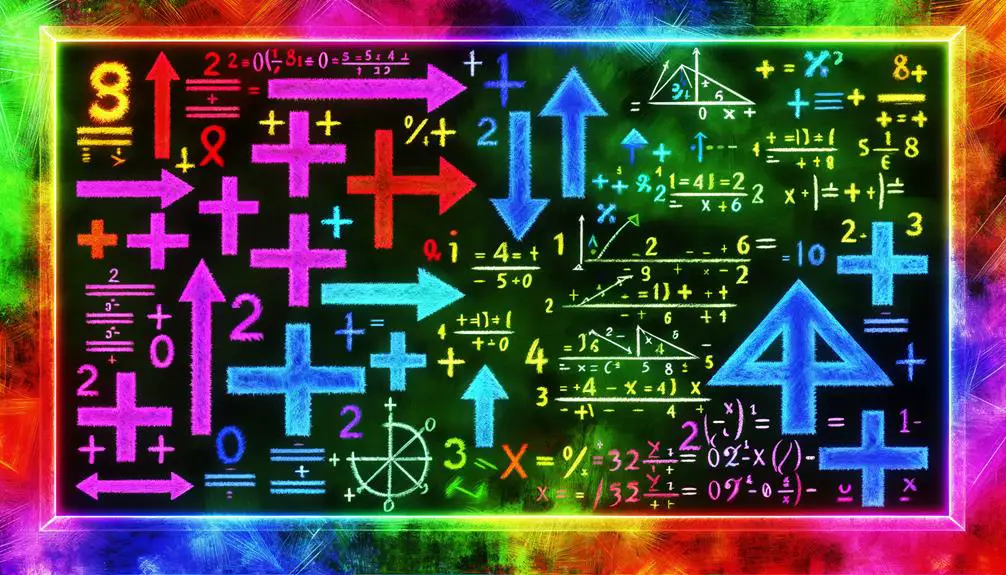
Addition and subtraction are fundamental arithmetic operations that form the basis for more advanced mathematical concepts.
Addition, denoted by the plus symbol (+), combines two or more quantities into a single sum. For instance, in the expression 3 + 4 = 7, the plus symbol signifies the aggregation of 3 and 4 to yield 7.
Conversely, subtraction, represented by the minus symbol (−), involves deducting one quantity from another. In the expression 9 − 5 = 4, the minus symbol indicates the removal of 5 from 9, resulting in 4.
Mastery of these operations is vital as they are integral to solving equations, understanding numerical relationships, and performing higher-level calculations in mathematics and its applications.
Multiplication and Division
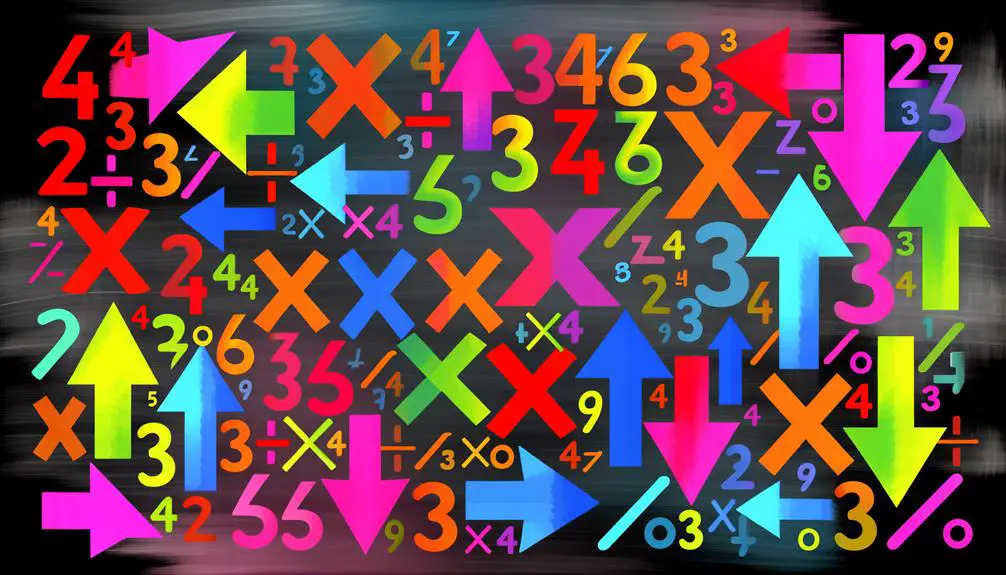
The symbols for multiplication (*) and division (÷) represent fundamental operations that extend the principles of addition and subtraction. Understanding their properties and rules, such as the commutative property of multiplication and the non-commutative nature of division, is critical for mathematical proficiency.
Practical applications of these operations range from solving algebraic equations to performing complex computations in various scientific fields.
Basic Operations Overview
Understanding multiplication and division is essential for mastering basic mathematical operations and solving complex problems efficiently. These operations form the foundation of arithmetic, enabling the manipulation and transformation of numbers in various contexts.
Multiplication involves combining equal groups to find a total. On the other hand, division entails splitting a total into equal parts or determining how many times one number is contained within another.
Multiplication:
Combines equal groups to yield a total.
Division:
Splits a total into equal parts or groups.
Multiplicative Inverse:
Key in reversing multiplication via division.
Quotient:
Result of a division operation.
Product:
Result of a multiplication operation.
Mastery of these operations is critical for advancing in mathematics, facilitating the understanding of more complex concepts.
Properties and Rules
Building on the fundamental concepts of multiplication and division, it is essential to understand the properties and rules that govern these operations to enhance problem-solving proficiency and mathematical comprehension.
Multiplication adheres to properties such as commutativity (e.g., \(a imes b = b imes a\)), associativity (e.g., \((a imes b) imes c = a imes (b imes c)\)), and the distributive property over addition (e.g., \(a imes (b + c) = a imes b + a imes c\)).
Division, while not commutative or associative, follows the rule of distribution over addition and subtraction in specific contexts (e.g., \((a + b) \div c = a \div c + b \div c\)).
Understanding these properties and rules is vital for algebraic manipulations and advanced mathematical problem-solving.
Practical Applications
Practical applications of multiplication and division permeate various fields such as engineering, economics, and data analysis, where they facilitate the computation of complex quantities, rates, and distributions. These operations are fundamental in numerous real-world scenarios:
- Engineering: Calculating load distributions and material stress.
- Economics: Determining cost functions and profit margins.
- Data Analysis: Normalizing data sets and calculating averages.
- Finance: Computing interest rates and loan amortizations.
- Supply Chain Management: Optimizing inventory levels and distribution schedules.
In engineering, multiplication and division are used to ensure structural integrity by calculating load-bearing capacities. Economists employ these operations to analyze market trends and forecast economic conditions. Data analysts use them to interpret and normalize data, guaranteeing accuracy in findings. Through these practical applications, multiplication and division prove indispensable in diverse professional contexts.
Equality and Inequality
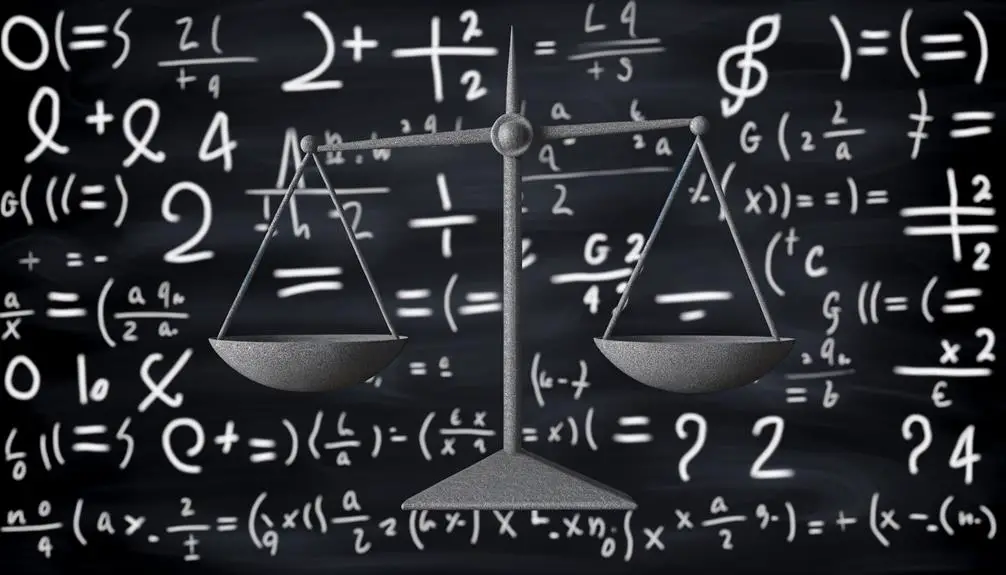
Equality and inequality are fundamental concepts in mathematics, each represented by specific symbols. The equality symbol (=) denotes that two expressions are exactly the same in value, emphasizing balance and equivalence.
In contrast, inequality symbols (>, <, ≥, ≤) express a relationship where one expression is greater or lesser than the other, highlighting differences in magnitude or value.
Equality Significance
In mathematical discourse, the equality and inequality symbols serve as fundamental tools for expressing relationships between quantities. Equality, denoted by the symbol '=', asserts that two expressions represent the same value, thereby maintaining balance and symmetry within equations. This concept is pivotal in algebra, calculus, and various branches of mathematics.
Key aspects of equality include:
- Equivalence: Establishing that two expressions are identical in value.
- Symmetry: If 'a = b', then 'b = a'.
- Transitivity: If 'a = b' and 'b = c', then 'a = c'.
- Reflexivity: Any mathematical quantity is equal to itself.
- Substitution: Equal quantities can replace each other within expressions.
These principles form the bedrock of mathematical logic and problem-solving, ensuring consistency and rigor in analytical processes.
Inequality Types
While equality denotes the sameness of values, inequalities introduce a different dimension by comparing quantities that are not necessarily equal.
Inequalities are fundamental in mathematics, represented by symbols such as \( < \) (less than), \( > \) (greater than), \( \leq \) (less than or equal to), and \( \geq \) (greater than or equal to). These symbols allow for the expression of relationships where values differ, enabling more complex problem-solving scenarios.
For instance, \( x < 5 \) specifies that \( x \) is any number less than 5, while \( y \geq 3 \) indicates \( y \) is 3 or greater. Understanding these types enhances one's capacity to tackle mathematical models and real-world applications involving constraints and optimization.
Parentheses and Brackets
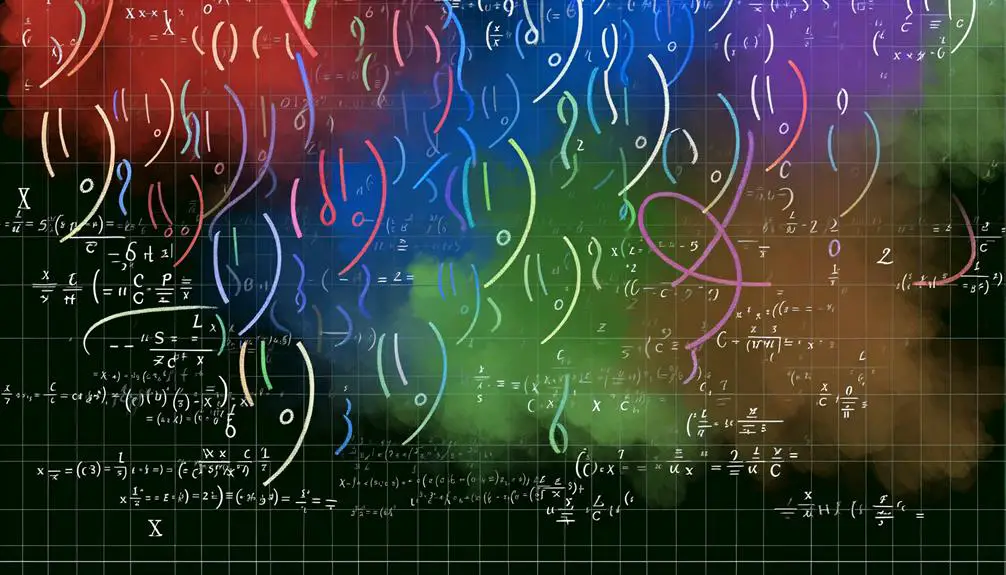
Parentheses and brackets are frequently used in mathematical expressions to indicate grouping and prioritize operations. Their proper use guarantees clarity and accuracy in complex calculations.
Parentheses, denoted by ( ), are typically used for the innermost grouping, while brackets, denoted by [ ], encompass secondary groupings, and braces, { }, for tertiary levels.
Key functions include:
- Grouping terms: Ensuring specific terms are calculated first.
- Order of operations: Clarifying the sequence in which operations are executed.
- Complex expressions: Simplifying the interpretation of intricate formulas.
- Nested structures: Managing multiple layers of calculations within an expression.
- Interval notation: Representing ranges of values, particularly in inequalities.
Understanding their application is essential for mathematical precision and effective problem-solving.
Exponents and Radicals
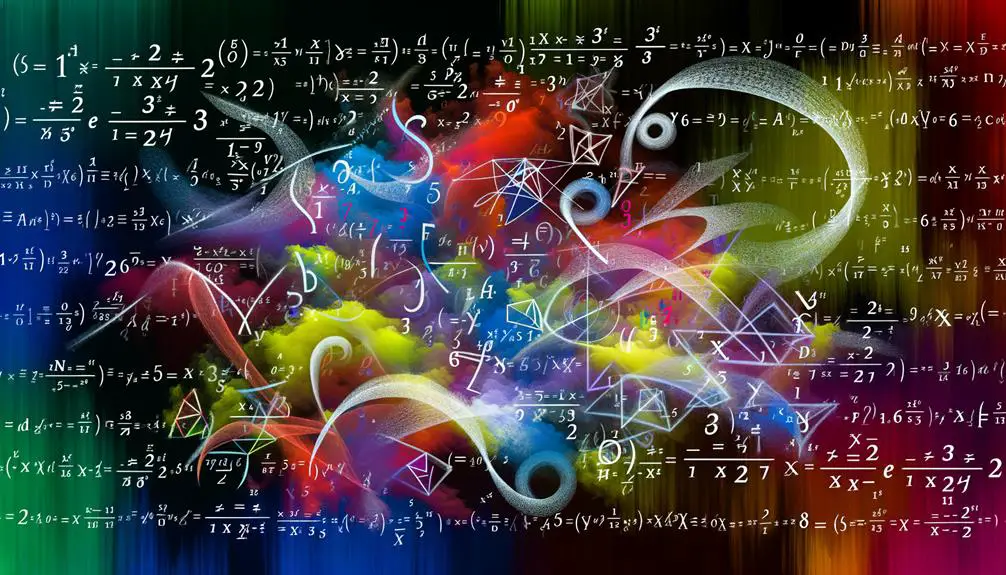
Exponents and radicals are essential concepts in mathematics that deal with powers and roots, respectively, enabling the concise representation and manipulation of repeated multiplication and root extraction.
An exponent denotes how many times a number, known as the base, is multiplied by itself. For instance, \(a^n\) implies multiplying \(a\) by itself \(n\) times.
Conversely, radicals involve the extraction of roots, with the square root symbol (\(\sqrt{}\)) being the most common. The expression \(\sqrt[n]{a}\) represents the \(n\)-th root of \(a\).
These concepts are vital for simplifying expressions, solving equations, and understanding higher-level mathematics. Mastery of exponents and radicals is necessary for progressing in algebra, calculus, and beyond.
Summation and Product
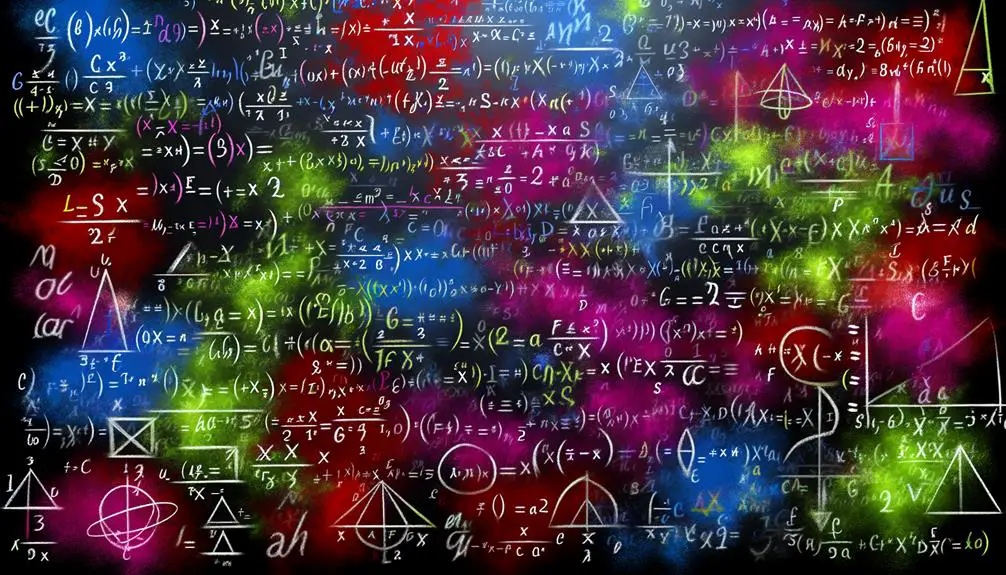
Summation and product operators are fundamental mathematical notations for representing the addition and multiplication of sequences of numbers, respectively. The summation operator, denoted by the Greek letter Σ, aggregates the sum of a sequence of terms.
Conversely, the product operator, denoted by the Greek letter Π, calculates the product of a sequence of factors. These notations are essential for simplifying expressions in various fields of mathematics.
- Summation (Σ): Adds up a series of numbers.
- Product (Π): Multiplies a series of numbers.
- Index of Summation/Product: Indicates the starting and ending points.
- Upper and Lower Limits: Define the range of the sequence.
- Compact Representation: Condenses lengthy arithmetic operations into concise expressions.
This analytical approach facilitates understanding complex mathematical relationships.
Probability and Statistics

In the field of probability and statistics, mathematical symbols serve as significant tools for representing complex concepts and facilitating the analysis of data.
Symbols such as \( P(A) \) denote the probability of an event \( A \), while \( \mu \) and \( \sigma \) represent the mean and standard deviation of a dataset, respectively.
The use of \( \Sigma \) indicates summation, often employed in calculating expected values.
Additionally, the symbol \( \chi^2 \) is vital in chi-squared tests for independence.
These symbols condense intricate ideas into concise notations, aiding in the clear communication of statistical methodologies and results. Mastery of these symbols is essential for professionals seeking to perform rigorous data analysis and derive meaningful insights.
Set Theory Symbols

While probability and statistics rely heavily on symbols for effective data analysis, set theory utilizes its own unique set of symbols to describe relationships between collections of objects. These symbols enable mathematicians to precisely communicate complex ideas about sets and their interactions. Understanding these symbols is fundamental for grasping higher-level mathematical concepts.
- ∈: Denotes membership; \(a ∈ A\) means element \(a\) is in set \(A\).
- ⊆: Indicates a subset; \(A ⊆ B\) means all elements of \(A\) are also in \(B\).
- ∅: Represents the empty set, a set with no elements.
- ∩: Symbolizes intersection; \(A ∩ B\) is the set containing elements common to \(A\) and \(B\).
- ∪: Denotes union; \(A ∪ B\) is the set of all elements in either \(A\) or \(B\).
Conclusion
In mathematical notation, each symbol serves a critical function in conveying complex ideas succinctly.
For instance, the symbol for summation (∑) allows for the concise representation of the sum of a sequence of terms.
A fascinating statistic is that the symbol for equality (=) was first introduced by Robert Recorde in 1557.
The diverse array of symbols, from basic operations to advanced concepts, forms the language through which mathematical relationships and structures are precisely communicated.




